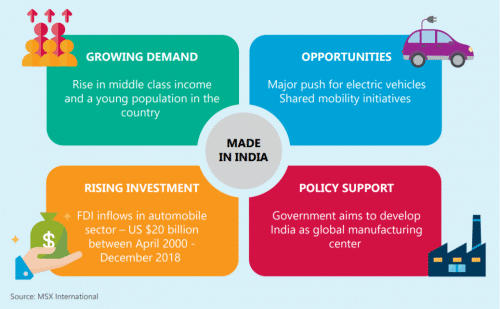
Spotlight: Automotive landscape in India
by Ingo Meyer, MSX VP Operations APMEA
At a glance
With over 26 million vehicles produced in the country in 2019, India is poised to generate US$ 300 billion in revenue, a contribution of 12% of total GDP and the creation of 65 million jobs by 2026. These are the aspirations set for the Automotive Mission Plan 2016-2026 – a vision document created by the Indian Government along with industry stakeholders to promote automotive businesses. These numbers reveal a glimpse of the potential that lies in the Indian
automotive industry. Currently, the automotive industry contributes more than 7% of the total GDP and employs about 32 million people. Strong domestic consumer demand, government initiatives, and urbanization have supported the Indian automotive industry’s current growth.
India’s market growth is driving mobility innovation
The rise of India to global dominance in the automotive industry is multifaceted. The will of the people to innovate their infrastructure is a driving factor. The installation of electric vehicle (EV) charging stations in metro areas is gearing up for the transformation to zero-emission vehicles – a commitment the country has made along with other industrialized nations.
Moreover, OEMs are investing greatly in technology incubators to unleash the innovation potential in the region, whereas future investment projects in the Pacific and the Americas are being hedged based on their current economic climate. The industry outlook suggests India may be the largest automotive market worldwide in the coming years – even bigger than China and the United States. The primary driver of this shift in automotive outlook is a recent development, in part due to large government investment in infrastructure that allows for technological innovations in the area of mobility, electric vehicles and manufacturing set-ups. The technology revolution in India has major implications for businesses seeking to grow in the automotive sphere.
Technological megatrends in India
India-based OEMs and Tier – 1 supplier have shown tremendous innovation in the local automotive landscape. EVs are today’s prime focus within the industry and government, but many activities are happening in the areas of connected cars, autonomous
driving, vehicle data generation and setting up of global research and development centers. Many start-ups have emerged which are focusing on artificial intelligence and machine learning applications in the automotive sector. Indian OEMs are also active on both the acquisition and alliance fronts with other companies and start-ups for shared mobility, e-mobility and powertrain solutions.
The last couple of years have also seen joint ventures happening between OEMs for developing connected vehicle projects, electric battery vehicles, battery technology and research and development in these areas. Automotive businesses are welcome and rewarded for their success and innovation, which benefits the region. These operations are a win-win for the people of India, creating a highly-skilled modern automotive workforce utilizing the engineering and computer science-driven culture. By giving more flexibility to stakeholders in India to build new operations facilities, auto manufacturing is booming. This is in stark contrast to the growing regulations and costs of franchising operations in Asia-Pacific and the Americas. The Indian government also acknowledges the challenges of environmental concerns, depleting fossil fuels and high import costs of fuel with conventional internal combustion engines. To tackle this challenge, the National Mission on Electric Mobility was launched in 2013. As a follow up, FAME (Faster Adoption and Manufacturing of Hybrid and Electric Vehicles in India) scheme was launched in 2015 to promote the EV ecosystem and related research and development activities. The second phase of this scheme was launched in 2019 which offers incentives on the purchase of EVs and established a charging infrastructure.
Digitization of India’s aftermarket
Higher earnings in India are driving vehicle sales, creating great opportunities for manufacturers and supply chains to develop effective aftermarket strategies. Aftermarket professionals in India are employing virtual technology for training purposes,
grasping new concepts, and furthering the knowledge base of repair service and maintenance techniques for the mobility market including replacement parts, accessories, and lubricants.



